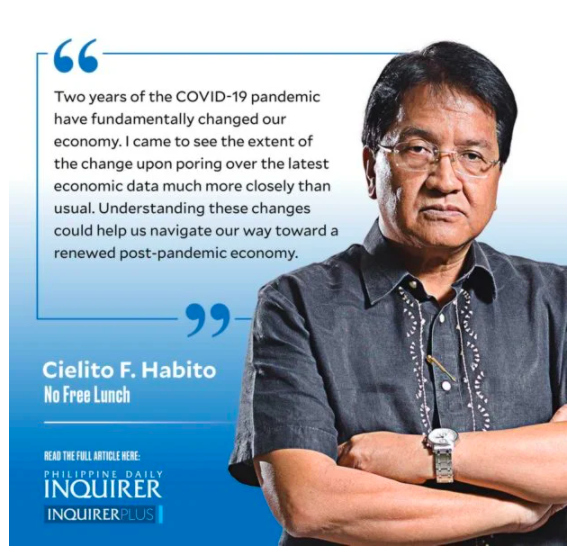A changed economy
Two years of the COVID-19 pandemic have fundamentally changed our economy. I came to see the extent of the change upon poring over the latest economic data much more closely than usual. Understanding these changes could help us navigate our way toward a renewed post-pandemic economy. Let me examine these changes based on the three elements of my usual “PiTiK test” of presyo (prices), trabaho (jobs), and kita (incomes).
The inflation rate that measures overall price increases has significantly risen, with an average 4.5 percent inflation rate for 2021 against only 2.5 percent in 2019. It’s not due to the COVID-19 human pandemic, but the African swine fever (ASF) pandemic that decimated about a third of our swine population, and pushed pork prices to nearly double. Thanks to eased imports and government aid for repopulating herds, meat inflation has eased from 11.3 percent in December to just 4.3 percent last month. Core inflation—which excludes from the measurement price-volatile commodities like food and fuel—actually remained steady at 3.2-3.3 percent, and this is what central banks watch to guide their management of money supply. And because our price surge traces to commodity supply problems rather than excess money supply, our Bangko Sentral looks to the government to exhaust efforts to address it at the root, rather than unleash its growth-inhibiting monetary fixes. Our inflation is still nowhere near the 7 percent Americans are now reeling under, and with the right government moves, ours should ease back down, as has already begun.
Meanwhile, we’ve seen a remarkable shift in jobs to agriculture, whose share in total employment rose to 24.57 percent from 23.45 in 2019. While the 1.12 percentage point difference may seem small, it is more substantial than it looks, and corresponds to 650,000 net additional jobs created in the farm, forestry, and fishery sector. This gain is large considering that the biggest single job losers—transport and storage, and accommodation and food services—each lost about as many jobs. Offsetting these services job losses was a net gain of 1.15 million jobs in wholesale and retail trade (likely more of the latter). Services saw a net gain of 353,000 jobs overall, even as its contribution to total employment fell slightly from 57.7 to 57.6 percent. Industry was the sectoral job loser, having shed 324,000 jobs, the bulk (288,000) being in manufacturing, followed by construction (70,000). The jobs story of the past two years was one where displaced industry and services sector workers massively shifted to farming, fishing, or trading jobs.
But it is the reallocation of production (hence incomes) across sectors and industries that suggests that the pandemic has induced a restructuring in our economy. The agriculture, fishery, and forestry sector is most interesting, having posted only a tiny decline of P8.3 billion (measured in constant 2018 prices) through the pandemic since 2019. In fact, if we exclude livestock from the measurement given its peculiar ASF problem, the rest of agriculture actually saw output and incomes defy the deep recession, rising by P47.6 billion since 2019. In stark contrast, industry and services fell by P356 billion and P510 billion, respectively. Outside of livestock, agriculture actually demonstrated resilience through the pandemic and natural disasters, as major crops like rice, corn, sugarcane, fruits, coffee, cacao, and rubber grew consistently in the last two years.
I’ve heard pessimists describe Philippine agriculture to be sinking, even dying. It’s actually quite the opposite, proving itself to be truly the backbone of the Philippine economy. Imagine, then, how much more we could achieve once we beat ASF and tap the wide scope for further raising productivity in the sector with higher budgets and needed governance and institutional reforms. Meanwhile, we’re witnessing the manufacturing sector restructure toward less concentration, while the services sector veers toward more digitalization and more health services in direct response to the recent challenges.
How we should move forward would have to be left for another article.
————
Disclaimer: The comments uploaded on this site do not necessarily represent or reflect the views of management and owner of Cebudailynews. We reserve the right to exclude comments that we deem to be inconsistent with our editorial standards.

